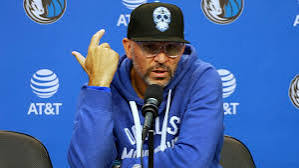As the 2025 NBA Draft looms just days away, the Dallas Mavericks are preparing to take a bold leap into the future. The franchise is locked in on selecting Cooper Flagg with the number one overall pick—a move that’s been all but confirmed after his exclusive private workout with the team. But while Flagg’s arrival is stirring hopes of a franchise savior, an unexpected twist in Dallas’ coaching strategy could throw a wrench into what should be a seamless transition.
Flagg isn’t just an athletic marvel—he’s a potential defensive cornerstone from the very first whistle. According to multiple insiders, his skill set mirrors some of the league’s most feared wing defenders. Fans should be celebrating, but there’s tension bubbling under the surface.
The source? Head coach Jason Kidd.
The Mavericks seem set on retaining Kidd for the long haul, which, on the surface, appears to be a wise decision. He’s survived front-office drama, injury-plagued seasons, and a rollercoaster ride post-Luka Doncic trade. But his loyalty to a controversial system might just put the entire Cooper Flagg era at risk.
Kidd has become synonymous with the “double-big lineup”—a scheme he clung to after the franchise brought in Anthony Davis. The system leans on deploying two centers simultaneously, and though it was barely implemented last season due to a rash of injuries, it remains his blueprint moving forward.
In a fresh radio appearance with 105.3 The Fan, Kidd pulled no punches about where he stands on the issue.
“We believe with the Mavs… we’re big. We can put out a big lineup… AD is 6’10, 7-feet, I think,” Kidd said. “I think that ability to athletically have bigs that can guard smalls, when you look at certain teams in this league, like Cleveland. They’re big, but they’re athletic. So you can start to see teams are playing with two bigs, it gives you an advantage on both ends.”
While Kidd’s words suggest strategic clarity, critics hear warning bells. Slotting Flagg into a starting five alongside giants like Anthony Davis and potentially Dereck Lively II or Daniel Gafford would create a towering wall—but also a tactical nightmare.
With three players over 6’9” clogging the floor, spacing becomes a dire concern. It’s not that Flagg can’t shoot—he’s respectable from the arc—but reducing a generational top pick to a catch-and-shoot role in the corner? That’s not just inefficient—it borders on basketball malpractice.
Worse yet, pairing Gafford, Davis, and Flagg could paralyze offensive fluidity. The paint would be packed, fast breaks hampered, and the shooting lanes narrowed into oblivion. Dallas could be staring down a future where their elite rookie is boxed into a rigid system that stifles creativity.
On the defensive end, sure, the Mavs could become a paint-protecting powerhouse. But the same issues that haunted them last year—namely poor perimeter containment—wouldn’t vanish just because Flagg steps on the court. He’s a game-changer, but even Flagg can’t defend five positions alone.
With the draft days away, Kidd’s refusal to abandon the two-big dream puts the Mavericks in a dilemma. Will they sacrifice the potential for an electrifying, fast-paced offense to stick to a system that’s already drawn criticism league-wide?
The looming decision: trade Daniel Gafford and bring in more versatile, younger talent to balance the floor—or go all-in on Kidd’s vision, Flagg’s development be damned.
Yet all signs point to the latter.
Jason Kidd is all in.
And the Dallas Mavericks’ future might be riding on a philosophy that the modern NBA has already begun to abandon.
